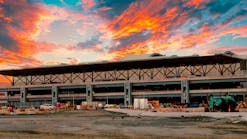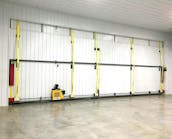LINCOLN, NE - Lincoln Airport, formerly Lincoln Municipal, is located some four miles from Lincoln's central business district. The largest tenant on the field, familiy-owned aircraft maintenance and refurbishment company Duncan Aviation, provides nose-to-tail aircraft MRO (maintenance, repair, and overhaul) service, working on everything from landing-gear to avionics to exterior aircraft painting.
Duncan president Aaron Hilkemann, who joined the company in 1996 with no aviation experience, says because he didn't have the industry technical knowledge at first, he has always focused on the employees, and how he can support them. "Give employees a good facility to work in, good training, and good equipment ... that ultimately has a significant impact on the customer," he says.
The company employs some 1,850, and apart from the Lincoln operation, Duncan operates facilities in Battle Creek, MI (BTL) and Provo, UT (PVU). The company also maintains several avionics and engine satellite repair stations across the country.
Hilkemann relates that business is doing well currently, and the company has seen a positive trend in terms of customer spending. From a customer service standpoint, Duncan has been entrenched in the social media arena utilizing websites such as Facebook and Twitter as an effective and efficient way to distribute information, technical or otherwise, to it's Web-savvy client base.
Full-service
Says Hilkemann, "Our goal is to do as many things on that large inspection: interior, refurbishment, avionics, repair … as much of the things that come up on that aircraft - we’d like to try to do as many things onsite as we can. That eliminates the risk of a customer having a late delivery because we’re waiting for someone else to provide us with those parts.
"We really want to be a full-capability shop so that we can control whatever comes up and provide the customer with whatever needs they may have." This helps the company control the delivery date, adds Hilkemann.
A specific example of Duncan's service capabilities include work with the company's water jet cutter. Duncan utilizes the machine to fabricate its own instrument panel for cockpits when it does Proline 21 installations, for example. "As we used it and continued to see the capabilities, there’s been times with older aircraft where a part took three to six months for a customer to get a part - we’ve had manufacturers provide us with drawings so we can fabricate those parts," says Hilkemann.
"It’s been a very multifunctional tool for us; gives us some more capability."
Trends; expansion
"We have seen customers during the recession significantly reduce their spending for discretionary items, such as paint and interior … that occurred during ’09 and the first half of 2010," relates Hilkemann. "We started to see in the second half of 2010, the beginning of some additional spending for discretionary items; that has continued to grow in 2011.
"So customers who put off spending are now starting to commit to aircraft improvements, such as painting, interior refurbishment, and as well as some discretionary items for avionics, or Wi-Fi in the cabin.
The industry saw a significant reduction in flying hours from the fall of 2008 to the first quarter of 2009, and that impacted customers, and therefore impacted the Duncan facility, explains Hilkemann.
"To react to that, we implemented a salary freeze … we ended up doing a salary reduction, and in March of 2009, we reduced our workforce by some 300 employees," he says. That was the first time in Duncan's history that the company has a reduced its workforce.
On any given day in Lincoln, Duncan typically has 55 aircraft onsite on average, and at the Battle Creek facility, there are some 35 aircraft onsite every day. Both facilities primarily work on jets; 95 percent of the company's market is jet aircraft.
On the avionics, component, and accessory side of the business, turboprops have a much higher percentage of the market.
"Our current plan is to build an additional paint facility at the Lincoln location," remarks Hilkemann. "It would have a large downdraft bay as well as a ‘dirty’ bay [paint stripping]; we still have our three existing paint bays as well.
"This allows us to paint aircraft that are too large for our existing hangars; it also allows us to increase our mix in Lincoln of the number of large aircraft paint slots that we have."
Investment in the facility is $10-11 million, and the company plans to have it complete by April of next year. With construction set to begin this spring, the facility will add 45,000 square feet to the existing 440,000-square foot facility on the east side of the airport. The new facility will be capable of servicing large business aircraft such as Gulfstream's 550, Bombaridier's Global Express, and Dassault's Falcon 7X.
Social Duncan
"We’ve seen some of our customers change over the years; in many cases they are younger, and they obviously [social media] tools to communicate," says Hilkemann.
Beth Humble, Duncan's communications specialist located at the Battle Creek facility, has been with the company for 12 years. "We’ve been using social media since the 2008/2009 timeframe; we started out really small and did more in subsequent years," relates Humble.
She began with a personal Facebook page and Twitter account to see who was out there, and found a lot of aviation people that were into social media from the beginning, then Duncan jumped in as a company in 2009.
Comments Humble, "It’s grown ever since; I lead it and our marketing department plugs into it.
"We dedicate probably half a person to our social media initiatives; several of us help manage and contribute to the sites."
Duncan's primary uses for social media include information distribution and brand awareness.
Comments Humble, "We’ve always had a lot of content on our website ... technical content, our magazine, and other publications that we contribute to. One of our goals is to make sure that our customers are smarter aviation people by doing business with us; our publications support that goal, and social media has been an important channel to distribute that message further.
"Our blogs, our technical publications, whitepapers, field guides … it’s very content driven. I think social media has helped us get better at providing good content." As a result, Humble says it's beginning to cause a significant increase in Duncan's website traffic.
"It’s also a good way to get in front of media outlets as well, and to let them know what we are doing; there are a lot of journalists on Twitter. I have access to some great aviation bloggers on Twitter that I wouldn’t have had if I wasn’t there."
Duncan has even gained customers directly from Twitter and Facebook; the company views social media as a great way to build relationships.
As for the future, Humble says this year the company really needs to get a good feel for where our customers are. "We need to identify which of our social media users are most likely to buy from us, and then work to develop more content for that area of the Web; then we will put more resources toward pushing information out to the right channels," she adds.
Duncan is also looking at mobile technologies, and distributing content that is specific to a particular community. "We want to look at that community piece and find out if we can develop a ‘Duncan Community'; this could have location-based marketing implications," remarks Humble.





